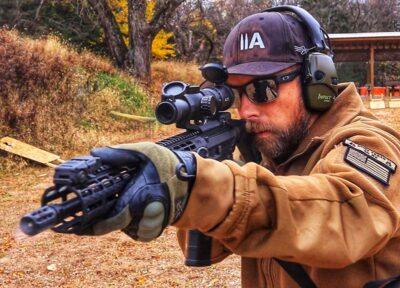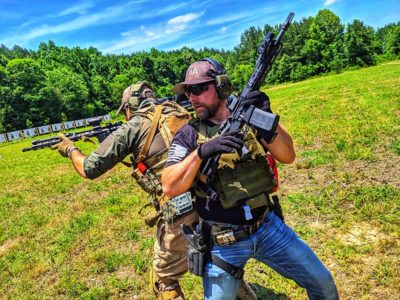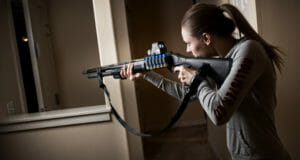The political climate has risen to a boiling point in the United States. It would seem that the possibility, while improbable, of another civil war could erupt at any given moment. With that in mind, it is always good to be ready for any type of civil unrest to defend yourself, your family and your home. But, when equipping your AR-15 with an optic which one would serve you best if you are in a “bug in” situation that could last one or more weeks? What optic would best suit you in a close quarter combat (CQB) and an open environment situation? That is what we are going to explore.
What Types of Optics Should I Consider?
With the booming popularity of the AR-15 in the last 15, or so, years, we have also seen a surge of innovation in the optics market. Starting with the Aimpoint M68 CCO red dot, we found that an optic could quickly be a combat multiplier in giving the shooter not only fast acquisition of a target but also the ability to place well aimed shoots up to 300 yards away. As technology advanced, more optics became desirable due to their ability to provide more features. Optics like the EOTech 512, and later the XPS-2, the Trijicon ACOG fixed 4 power optic, Primary Arms 1-6x24mm variable scope with the ACSS reticle are just a few of the advancements in sight technology.
Why a Red Dot May Not Be the Best?
There is no doubt that a red dot is an excellent choice in an optic for your AR-15. The Trijicon MRO or Aimpoint Micro T-2 are excellent choices. They have the ability to find and engage a target quickly. In low light situations, some red dots can be coupled with night vision goggles to increase your lethality. High end red dots also have battery life that can sustain operation for 50,000 hours of continued use. However, they do have limitations. Shooting targets at distance can be challenging without the use of an added magnifier. This will add more items to your rifle that translates to a heavier rifle. In addition, if you have astigmatism, red dots can be difficult to use since the dot may be hard to see. Depending on the severity of your astigmatism, a red dot may appear as a star burst or several dots in a line. This may eliminate this sight for a lot of people.
Are Holographic Sights Better than Red Dots?
As mentioned, red dots are an excellent option; however, a holographic sight like the EOTech 512 or XPS-2 may be superior to the red dot. For those that are plagued with astigmatism, a holographic sight will not look distorted due to the use of mirrors and a laser to generate the reticle. A red dot uses a LED light that reflects off the front lens to the shooters eye. A sight like an EOTech can sustain damage to the lens, or lose it completely, and still project a reticle making it far more durable. Any damage to a red dot’s front lens could spell disaster for the shooter due to the design and technology required for a red dot to work. However, a holographic sight does have one disadvantage to the red dot and that is battery life. A laser requires far more energy to operate than a LED light and battery life is usually relegated to about 1,000 hours of continuous operation. That could also be an issue for someone that does not have access to replacement batteries.
Fixed Power Optics Suck for CQB…
Fixed power optics, like the Trijicon ACOG, are another great option for AR-15s. In the last 5 to 10 years, we have seen more military units begin to use fixed power optics to allow additional lethality to the Soldiers or Marines. These sights allow a shooter to better see a target which allows for more accurate round placement. Newer versions of the ACOG even have fiberoptic illuminated reticle that assists in finding the reticle. Yet, with the increased magnification does hinder a fixed power optic from being the best option for CQB. If you are in an urban environment and must maneuver in and/or around homes, apartments, or other types of buildings the ACOG may be too much optic for what you need.
Why LPVO are the Most Versatile?
 Red dots, holographic sights, and fixed power optics are all fine choices; however, the low power variable optics (LPVOs) have the most versatility built into them. A great example is the Primary Arms 1-6x24mm FFP ACSS scope. This optic is a first focal plane sight that can be set on a magnification from 1 power up to 6 power for long range shots. The ACSS reticle is the pinnacle of innovation with optic technology by providing a reticle that allows the shooter the ability to be precise in aiming but also provide ranging capabilities as well as bullet drop compensation. It even allows the shooter to shoot moving targets by using the built-in lead points. A first focal place LPVO mimics a red dot at 1 power since the ACSS reticle will reduce in size to appear to be a dot. The reticle for the Primary Arms LPVO can be illuminated and features 11 brightness settings. In most higher end offerings, the reticle will be etched into the glass that will ensure durability if the optic gets knocked around.
Red dots, holographic sights, and fixed power optics are all fine choices; however, the low power variable optics (LPVOs) have the most versatility built into them. A great example is the Primary Arms 1-6x24mm FFP ACSS scope. This optic is a first focal plane sight that can be set on a magnification from 1 power up to 6 power for long range shots. The ACSS reticle is the pinnacle of innovation with optic technology by providing a reticle that allows the shooter the ability to be precise in aiming but also provide ranging capabilities as well as bullet drop compensation. It even allows the shooter to shoot moving targets by using the built-in lead points. A first focal place LPVO mimics a red dot at 1 power since the ACSS reticle will reduce in size to appear to be a dot. The reticle for the Primary Arms LPVO can be illuminated and features 11 brightness settings. In most higher end offerings, the reticle will be etched into the glass that will ensure durability if the optic gets knocked around.
Wrapping It Up…
All modern optics are going to suit most people well on their AR-15. Yet, having the ability to use an optic like a red dot or increase the magnification to 6 power quickly makes the LPVO the best option. Every sight will have pros and cons; however, the LPVO pros outweigh the cons. For a reality where you may be forced to protect your family and property for prolong periods of time, the ability to have an illuminated sight, if desired, and the flexibility to choose the magnification needed for the scenario that is front of you makes it the optimal option for a “bug in or out” situation. Since the reticle is not dependent on being illuminated, batteries may not be a major concern when put in a situation where they are not readily available. Regardless what optic your preference is, you can only be as lethal as your training allows. Choose a sight and train to ensure your proficiency gives you the best opportunity to make it out of any situation.
About Mark Grimsley
Mark Grimsley is a former U.S. Army Officer that started his career as an enlisted Abrams crewman. He has served in 3 overseas tours that include Korea in 2002, Iraq in 2003 as a tank gunner and Afghanistan in 2010-11 as a logistics officer. He completed numerous schools in the Army to include Air Assault and Airborne. Currently, Mark is an Army spouse and enjoys running a YouTube channel
 Off The Grid News Better Ideas For Off The Grid Living
Off The Grid News Better Ideas For Off The Grid Living




